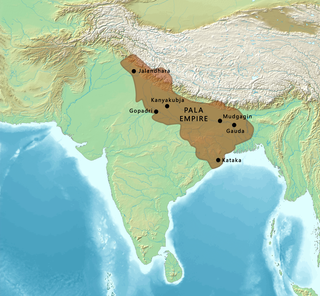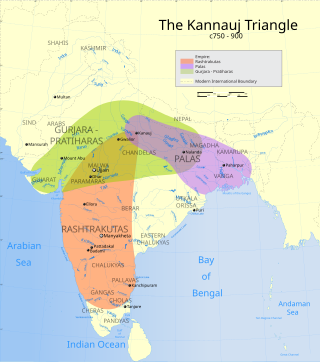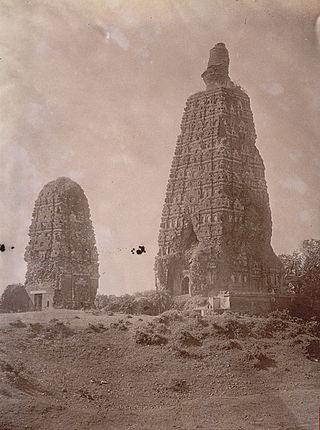Related Research Articles

The Pāla Empire was an imperial power during the post-classical period in the Indian subcontinent, which originated in the region of Bengal. It is named after its ruling dynasty, whose rulers bore names ending with the suffix Pāla. The empire was founded with the election of Gopāla as the emperor of Gauda in late eighth century CE. The Pala stronghold was located in Bengal and eastern Bihar, which included the major cities of Gauḍa, Vikramapura, Pāṭaliputra, Monghyr, Somapura, Ramavati (Varendra), Tāmralipta and Jaggadala.

Mihira Bhoja or Bhoja I was a king belonging to the Gurjara-Pratihara Dynasty. He succeeded his father Ramabhadra. Bhoja was a devotee of Vishnu and adopted the title of Ādivarāha which is inscribed on some of his coins. One of the outstanding political figures of India in ninth century, he ranks with Dhruva Dharavarsha and Dharmapala as a great general and empire builder.

Dhruva was one of the most notable rulers of the Rashtrakuta Empire. He ascended the throne after replacing his elder brother Govinda II. Govinda II had become unpopular among his subjects on account of his various misconducts as a ruler, including excessive indulgence in sensual pleasures. This according to the historian Kamath is evident from the Karhad plates of Krishna III. The Dhulia grant of 779 and Garugadahalli inscription of 782 proclaim Dhruva the emperor. Though some historians claim that Dhruva revolted and grabbed the throne, other historians feel the transition of the throne from Govinda II to Dhruva was peaceful and may have happened willingly. He earned titles like Kalivallabha, Srivallabha, Dharavarsha, Maharajadhiraja and Parameshvara.

The Kamboja-Pala dynasty ruled parts of Bengal in the 10th to 11th centuries CE, after invading the Palas during the reign of Gopala II. The last Kamboja ruler of the Kamboja-Pala Dynasty Dharmapala was defeated by the south Indian Emperor Rajendra Chola I of the Chola dynasty in the 11th century.

Bikrampur was a pargana situated 19 kilometres (12 mi) south of Dhaka, the modern capital city of Bangladesh. In the present day, it is known as the Munshiganj District of Bangladesh. It is a historic region in Bengal and was a part of the Bhawal Estate.
Devapala was the most powerful ruler of the Pala Empire of Bengal region in the Indian Subcontinent. He was the third king in the line, and had succeeded his father Dharamapala. Devapala expanded the frontiers of the empire by conquering the present-day Assam and Orissa. The Pala inscriptions also credit him with several other victories, but these claims are thought to be exaggerated.
Gopala was the founder of the Pala dynasty of Bihar and Bengal regions of the Indian Subcontinent. The last morpheme of his name Pala means "protector" and was used as an ending for the names of all the Pala monarchs. Pala does not suggest or indicate any ethnic or caste considerations of the Pala dynasty. He came to power in later half of eighth century AD in Gaur/Gaud after being elected by a group of regional chieftains.

Dharmapala was the second ruler of the Pala Empire of Bengal region in the Indian subcontinent. He was the son and successor of Gopala, the founder of the Pala Dynasty. He greatly expanded the boundaries of the empire, and made the Palas a dominant power in the northern and eastern India.

Narayanapala was the seventh emperor of the Pala dynasty of the Eastern regions of the Indian subcontinent, mainly the Bengal and Bihar regions.

Mahendrapala was the fourth king of the Pala dynasty of the Bengal region of the Indian subcontinent. He was the son of Devapala and his queen Mahata.

Rajyapala was the eighth emperor of the Pala dynasty. He succeeded his father Narayanapala. He reigned for 32 years. The Bharat Kala Bhaban is dated in his 2nd regnal year, while the Bargaon inscription is dated in his 24th regnal year. He was succeeded by his son Gopala III.

Gopala II was the successor to the Pala king Shurapala I in the Bengal-Bihar region of the Indian subcontinent, and the sixth ruler of the Pala line reigning for at least four years. The existence of this king came to light when, in 1995, historian Gouriswar Bhattacharya discovered two copper plate inscriptions of a previously unknown Pala king in Los Angeles County Museum of Art, where these had been sent for cleaning by a private collector. This king got designated as Gopala II; consequently, existing Gopala II and Gopala III were re-designated as Gopala III and Gopala IV, respectively. The text of these two inscriptions were subsequently edited by Ryosuke Furui in 2009.
Vigrahapala III was the successor to the Pala king Nayapala in the Bengal region of the Indian subcontinent, and twelfth ruler of the Pala line reigning for 15 years. He was succeeded by Mahipala II.
Mahipala II was the successor to the Pala king Vigrahapala III in the Bengal region of the Indian subcontinent, and thirteenth ruler of the Pala line reigning for 6 years. He was succeeded by Shurapala II.
Ramapala was the successor to the Pala king Shurapala II in the Bengal region of the Indian subcontinent, and fifteenth ruler of the Pala line.
Madanapala was the successor to the Pala king Gopala IV in the Bengal region of the Indian subcontinent, and eighteenth and final ruler of Pala lineage reigning for 18 years. He was succeeded by Govindapala, whose lineage of that name is questionable.

Kamarupa – Late to end period was a period of Kamarupa kingdom from founding of Pala Dynasty by Brahma Pala to last ruler of dynasty Jaya Pala.

Shurapala I was a 9th-century ruler of the Pala Empire, in the Bengal region of the Indian subcontinent. He was the fifth Pala emperor. He ruled for at least 12 years.
The Bhauma dynasty, also known as Kara dynasty, ruled in eastern India between 8th and 10th centuries. Their kingdom, called Toshala, included parts of present-day Odisha.

The Pīṭhīpatis of Bodh Gaya were the rulers of the area around Bodh Gaya from roughly the 11th to 13th centuries in the Magadha region of what is now Bihar in India. Pithi refers to the diamond throne where the Buddha was said to have gained enlightenment.
References
- ↑ Mishra, Vijayakanta (1979). Cultural Heritage of Mithila. Mithila Prakasana. p. 39.
- 1 2 Susan L. Huntington (1 January 1984). The "Påala-Sena" Schools of Sculpture. Brill Archive. ISBN 90-04-06856-2.
- ↑ Dilip Kumar Ganguly (1 January 1994). Ancient India, History and Archaeology. Abhinav Publications. p. 29. ISBN 978-81-7017-304-5.
- ↑ George E. Somers (1 January 1977). Dynastic History Of Magadha. Abhinav Publications. pp. 188–. ISBN 978-81-7017-059-4.
- ↑ The Cambridge Shorter History of India. CUP Archive. pp. 144–. GGKEY:2W0QHXZ7K40.